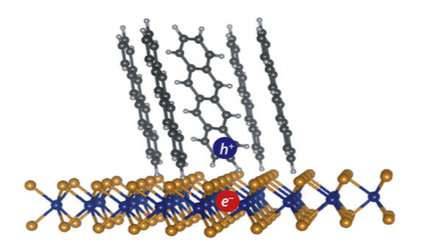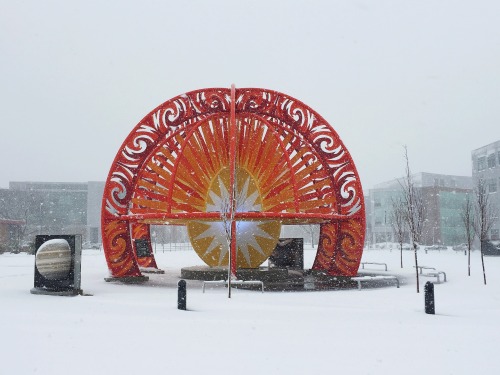#purdue university
Superstrong Al alloys may change manufacturing processes for automobiles, aerospace devices
Purdue University researchers have developed a superstrong material that may change some manufacturing processes for the aerospace and automobile industries.
The Purdue team, led by Xinghang Zhang, a professor in Purdue’s School of Materials Engineering, created high-strength aluminum alloy coatings. According to Zhang, there is an increasing demand for such materials because of their advantages for automakers and aerospace industries.
“We have created a very durable and lightweight aluminum alloy that is just as strong as, and possibly stronger than, stainless steel,” Zhang said. “Our aluminum alloy is lightweight and provides flexibility that stainless steel does not in many applications.”
Another member of the Purdue team, Yifan Zhang, a graduate student in materials engineering, said the aluminum alloy they created could be used for making wear- and corrosion-resistant automobile parts such as engines and coatings for optical lenses for specialized telescopes in the aerospace industry.
Post link
Silk Fibers May Represent Natural Metamaterials, Capable of light Confinement
New research has demonstrated how the nano-architecture of a silkworm’s fiber causes “Anderson localization of light,” a discovery that could lead to various innovations and a better understanding of light transport and heat transfer.
The discovery also could help create synthetic materials and structures that realize the phenomenon, named after Nobel laureate Philip Anderson, whose theory describes how electrons can be brought to a complete halt in materials due to their “scattering and defects.” The new findings relate not to electrons, but to light transport.
Researchers demonstrated how the nano-architecture of the silk fibers is capable of light “confinement,” a trait that could provide a range of technological applications including innovations that harness light for new types of medical therapies and biosensing. This light-confinement effect in biological and natural tissue, which was unexpected, is made possible by the Anderson localization of light, said Young Kim, an associate professor in Purdue University’s Weldon School of Biomedical Engineering.
The new findings suggest silk fibers may represent “natural metamaterials” and “natural metastructures,” Kim said.
Post link
Fast-moving electrons create current in organic solar cells
Researchers at Purdue University have identified the mechanism that allows organic solar cells to create a charge, solving a longstanding puzzle in physics, according to a paper published Friday (Jan. 12) in the journal Science Advances.
Organic solar cells are built with soft molecules, while inorganic solar cells, often silicon-based, are built with more rigid materials. Silicon cells currently dominate the industry, but they’re expensive and stiff, while organic cells have the potential to be light, flexible and cheap. The drawback is that creating an electric current in organic cells is much more difficult.
To create an electrical current, two particles, one with a negative charge (electron) and one with a positive charge (electron-hole), must separate despite being bound tightly together. These two particles, which together form an exciton, usually require a manmade interface to separate them. The interface draws the electron through an electron acceptor and leaves the hole behind. Even with the interface in place, the electron and hole are still attracted to each other – there’s another mechanism that helps them separate.
“We discovered that this type of electron-hole interface is not one single static state. The electron and the hole can be far apart or close together, and the farther apart they are, the more likely they are to separate,” said Libai Huang, an assistant professor of chemistry in Purdue’s College of Science, who led the research. “When they’re far apart, they’re actually very mobile, and they can move pretty fast. We think that this kind of fast motion between the positive and negative charge is what’s driving separation at these interfaces.”
Post link
Quantum material is promising ‘ion conductor’ for research, new technologies
Researchers have shown how to shuttle lithium ions back and forth into the crystal structure of a quantum material, representing a new avenue for research and potential applications in batteries, “smart windows” and brain-inspired computers containing artificial synapses.
The research centers on a material called samarium nickelate, which is a quantum material, meaning its performance taps into quantum mechanical interactions. Samarium nickelate is in a class of quantum materials called strongly correlated electron systems, which have exotic electronic and magnetic properties.
The researchers “doped” the material with lithium ions, meaning the ions were added to the material’s crystal structure.
The addition of lithium ions causes the crystal to expand and increases the material’s conduction of the ions. The researchers also learned that the effect works with other types of ions, particularly sodium ions, pointing to potential applications in energy storage.
Post link

Credit: Purdue University photo/Rebecca McElhoe
By Shardell Joseph
Engineers have developed a handheld paper divide able to detect a strain of coronavirus quickly and accurately. The strain, MERS-CoV, can be detected by the device in very small quantities, and can be read directly from the device making it portable.
As one of the select few given permission by USA health officials to use diagnostics tests for COVID-19, the Purdue University biomedical engineers claimed that this device could be used to detect the COVID-29 strain – the limitations in doing so currently is the lack of funding. According to the team, the process to scale the technology for manufacturing would cost at least a couple of million US dollars.
‘Paper-based devices are already manufactured – pregnancy tests are paper-based,’ said Purdue University Biomedical Engineering Professor, Jacqueline Linnes.
‘Because this device has a more complex shape, a process hasn’t been developed to make it available on a commercial scale. However, many processes in electronics and paper manufacturing could be translated to scaling up this device.’
But so far, Linnes’ team has just been able to produce these devices on a lab scale, which calls for cutting out the paper components by hand.
‘The most difficult aspect of producing this device is definitely the assembly,’ said Purdue University Biomedical Engineering PhD Cadidate, K Byers.

This time-lapse video shows how a paper device developed by Purdue researchers tests a sample in 40 minutes. This sample is positive for MERS-CoV, as indicated by the formation of a second line on the paper strip. Credit: Purdue University video/K Byers
These challenges may easily be overcome with existing manufacturing techniques, the researchers said.
The device format would not need to change in order to detect other diseases. As the device scales up, however, it would also need to be more sensitive to detect a lower concentration of a virus for clinical relevance.
‘This paper device isn’t dependent on a particular virus or sequence. To detect COVID-19, we would just need an assay design specific to that sequence, which could come from a nasal or throat swap sample. Just like with MERS-CoV, a user could load the assay with liquid into the paper platform, fold the device and let it run,’ Linnes said.
When the device folds over, a liquid wash and chemical substances called reagents push the assay up a paper strip to make an easily visible detection line. This automatically completes a multistep process needed for detecting a virus. A user can check the strip within 40 minutes to see if the sample tested positive.
Read the full paper at: https://pubs.acs.org/doi/full/10.1021/acsomega.0c00115?_ga=2.52130409.1579527955.1583773474-378642389.1583773474
Purdue Mall Engineering Fountain with The Purdue Bell Tower and Hovde Hall at the backdrop.
Post link
University Hall at Purdue University - built in 1877, it is one of the first six buildings of the Purdue campus.
Post link









